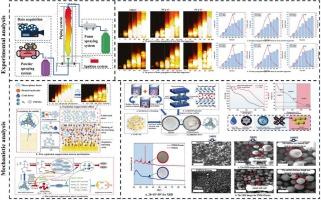Experimental investigation and mechanistic analysis of PMMA dust explosion suppression by a novel three-phase-gel foam
IF 5.9
3区 工程技术
Q1 CHEMISTRY, MULTIDISCIPLINARY
Journal of Industrial and Engineering Chemistry
Pub Date : 2025-06-13
DOI:10.1016/j.jiec.2025.06.020
引用次数: 0
Abstract
Dust explosions represent a highly hazardous incident in industrial production. Polymethyl Methacrylate (PMMA), as a widely utilized synthetic material, poses significant explosion risks in its dust form. Addressing the limitations of current dust explosion suppressants, such as their simple composition and limited effectiveness, this study investigates the suppression performance and mechanism of a novel three-phase-gel foam on PMMA dust explosions. Explosion characteristics were analyzed across PMMA particle sizes (200 to 2000 mesh) and concentrations (128–641 g/m3). Suppression experiments comparing water mist and the new foam were conducted for 500 and 2000 mesh powders. Results show that finer particles and higher concentrations increase explosion intensity and risk of secondary explosions. The three-phase-gel foam exhibited superior suppression to water mist, especially at 500 mesh and 128 g/m3, achieving a 32.09 % reduction in flame length and 59.73 % in peak velocity, with appearance times extended by 332 ms and 248 ms. Mechanism analysis via TG-DSC, SEM, and XRD revealed that the foam’s thermal stability, adhesion, and multi-phase structure form an effective barrier, enhance cooling, and inhibit radical chain reactions. These findings demonstrate the foam’s strong potential as a multi-mechanism dust explosion suppressant, offering practical value for industrial safety.

新型三相凝胶泡沫抑制PMMA粉尘爆炸的实验研究及机理分析
粉尘爆炸是工业生产中的一种高度危险事件。聚甲基丙烯酸甲酯(PMMA)是一种广泛使用的合成材料,其粉尘形式具有重大的爆炸危险。针对现有粉尘爆炸抑制剂成分单一、效果有限的局限性,研究了一种新型三相凝胶泡沫对PMMA粉尘爆炸的抑制性能和机理。分析了不同PMMA粒径(200 - 2000目)和浓度(128-641 g/m3)的爆炸特性。对500目和2000目粉末进行了水雾和新型泡沫的抑制实验。结果表明,颗粒越细、浓度越高,爆炸强度越大,二次爆炸危险性越大。三相凝胶泡沫对水雾的抑制效果较好,特别是在500目和128 g/m3时,火焰长度减少32.09%,峰值速度减少59.73%,出现时间分别延长332 ms和248 ms。通过TG-DSC、SEM和XRD等分析表明,泡沫的热稳定性、粘附性和多相结构形成了有效的屏障,增强了冷却,抑制了自由基链反应。这些发现表明,泡沫作为一种多机理的粉尘爆炸抑制剂具有很强的潜力,为工业安全提供了实用价值。
本文章由计算机程序翻译,如有差异,请以英文原文为准。
求助全文
约1分钟内获得全文
求助全文
来源期刊
CiteScore
10.40
自引率
6.60%
发文量
639
审稿时长
29 days
期刊介绍:
Journal of Industrial and Engineering Chemistry is published monthly in English by the Korean Society of Industrial and Engineering Chemistry. JIEC brings together multidisciplinary interests in one journal and is to disseminate information on all aspects of research and development in industrial and engineering chemistry. Contributions in the form of research articles, short communications, notes and reviews are considered for publication. The editors welcome original contributions that have not been and are not to be published elsewhere. Instruction to authors and a manuscript submissions form are printed at the end of each issue. Bulk reprints of individual articles can be ordered. This publication is partially supported by Korea Research Foundation and the Korean Federation of Science and Technology Societies.

 求助内容:
求助内容: 应助结果提醒方式:
应助结果提醒方式:


